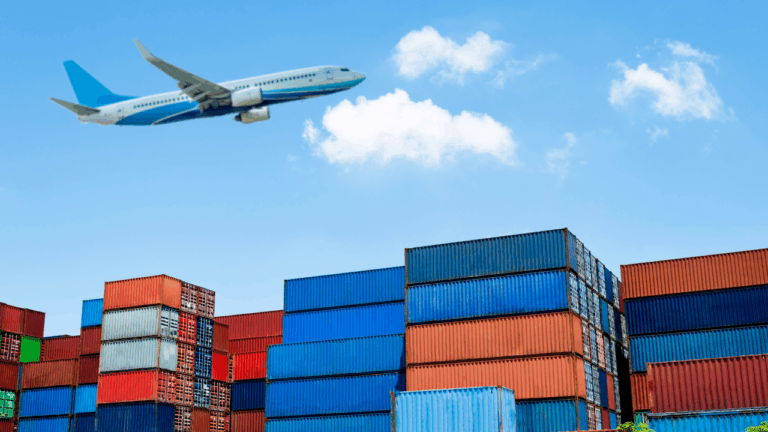46 Percent Savings in Air Freight
A globally operating machinery manufacturer has optimized its freight costs – with remarkable results: air freight costs were reduced by 46 percent without lowering the service level. In this interview, Robert Steinbrück, Senior Logistics Consultant at Kloepfel by EPSA, explains how the project unfolded and what led to its success.
1. Please briefly introduce the company.
Our client is a machinery manufacturer headquartered in Germany, with global production, sales, and service locations.
2. Was a potential analysis carried out before the project? If so, how was it conducted?
Yes. Before the project started, a potential analysis was conducted. We reviewed the total freight spend of around €11.1 million, defined approximately €7.6 million as addressable, and analyzed €4.8 million in detail.
Our data basis included current invoices, rate sheets, shipment data, and accounts payable figures. For road transport, we used benchmarks from our project database (comparable routes, cost per km). For sea and air freight, we worked with Xeneta and cross-checked the results using conservative benchmarks. This way, we consistently evaluated the price-performance ratio, incorporating service requirements into our benchmarks – the key factor was not the lowest price, but the best combination of cost and service.
3. How were potential savings identified – not only in terms of cost, but also in terms of the best price-performance ratio?
In air freight, we first analyzed existing routings and transit times. This is crucial both for the analysis and the project itself, since the client’s requirements and current service levels are the benchmarks we use for comparison and negotiation.
In parallel, we identified additional service levers – for example, in sea freight we optimized demurrage (terminal storage costs beyond free days) and detention (container use outside the terminal). We also addressed import-related issues, such as advancement fees (forwarder fees for prefinancing customs or taxes).
Our benchmarks are always tailored to the client’s requirements – cheaper only counts if the service level is at least as good or better.
Results of the potential analysis: around 39% savings potential in sea and air freight, about 20% in road transport; no potential was identified in the CEP segment (courier, express, parcel), as rates were already highly competitive.
4. What were the project objectives?
First, to realize the identified savings potential – while maintaining or even improving the existing service level. Second, to make the transport chain operationally more robust, for example through optimized demurrage and detention times, route optimizations, shipment consolidation, and better management of advancement fees. Third, to increase governance and transparency by introducing standardized tender processes, clear framework conditions, KPIs, and reporting structures – enabling both short-term quick wins and medium- to long-term improvements.
5. What savings were actually achieved? Were there any quick wins?
The results overall exceeded the conservative potential analysis: 46 percent savings in air freight, 51 percent in road transport, and 34 percent in sea freight.
6. What specific levers were used in air freight, the main savings area?
Previously, the air freight supplier base was very concentrated – only two providers. We opened it up, conducted a broad tender, and targeted “perfect matches.” The main levers were routing optimization and service benchmarking (reliable airlines, stable lead times), backed by solid Service Level Agreements. We also renegotiated cost-relevant surcharges such as advancement fees for imports. Rate sheets were consistently tied to the client’s requirements. The underlying processes remained largely unchanged – the primary lever was professional procurement.
7. What challenges arose during the air freight project, and how were they overcome?
The air freight routings were partly very demanding. Therefore, after shortlisting, we conducted detailed end-to-end supplier meetings to verify each forwarder’s capabilities – including pre-carriage, cargo security, airport cut-off times, airlines and routings (direct vs. stopover, single booking vs. consolidation), available weekly capacities (tonnage), handling at destination (unloading/unpacking), document flow, and delivery performance.
For each route, we compared the target timeline (dispatch day X → arrival Y) with the proposed offer. Only suppliers who fully met all requirements were recommended – even if lower rates were available elsewhere.
8. Were there any changes to transport or logistics processes to achieve the air freight savings?
No. The transport and logistics processes remained essentially unchanged. The impact came from market engagement, routing and service benchmarking, and improved procurement.
9. Given the high market volatility, how does the client ensure visibility to detect price increases early and sustain savings?
Through consistent, broad-based tenders as a regular process. Comprehensive market screening is essential for volatile trade lanes – it keeps both price and service levels transparent and negotiable.
10. What lessons can other companies learn from this project?
A professionally managed, broad-based tender process with clear requirements and robust benchmarks is the most powerful lever.
Savings don’t always come from eliminating “old margins” of existing providers – they often result from broad market coverage and a detailed approach that identifies perfect supplier-client matches. In other words, finding freight forwarders whose current setup fits the client perfectly, allowing them to offer excellent prices without compromising performance.
11. Beyond technical expertise, the human factor also plays an important role. How was the collaboration with Kloepfel by EPSA?
Very good and based on trust. We met in person on site, and it was important to the client that we strictly followed their requirements rather than simply searching for the cheapest provider. Many of our consultants are trained forwarding agents and have also worked on the shipper side – this shared language fosters understanding and acceptance.

Contact:
Kloepfel by EPSA
Damir Berberovic
Tel.: +49 211 941 984 33 | Email: rendite@kloepfel-consulting.com
